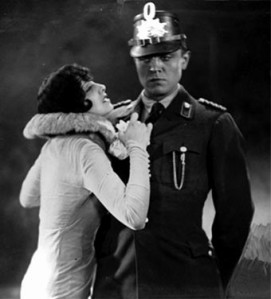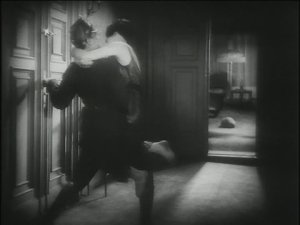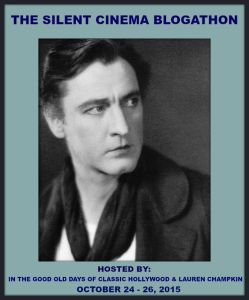 As a noir blogger, I have yet to post on silent films, for mostly obvious reasons. One can, however, find gems of pre- or proto-noir, particularly in the silents of Weimar cinema. So, when In the Good Old Days of Classic Hollywood announced a silent cinema blogathon, I searched for just the right film to bring what I love about noir together with what I love in silent movies. I found the perfect combination in Joe May’s Asphalt.
As a noir blogger, I have yet to post on silent films, for mostly obvious reasons. One can, however, find gems of pre- or proto-noir, particularly in the silents of Weimar cinema. So, when In the Good Old Days of Classic Hollywood announced a silent cinema blogathon, I searched for just the right film to bring what I love about noir together with what I love in silent movies. I found the perfect combination in Joe May’s Asphalt.
Best known to Americans for B films such as The Invisible Man Returns and The House of Seven Gables (both 1940), Joe May (born Joseph Otto Mandel) was one of the founders of German cinema, even giving Fritz Lang his start. Like many Jews in the Weimar film industry, May fled to the US and worked for Universal, but never found the success he had in his native country. Most compelling in what Hollywood offered him for noir lovers is perhaps 1937’s Confession with Kay Francis.
Asphalt is one of his last films made in Germany, and it shows how well May might have fit into noir direction, had he been given such films to direct. Though perhaps not as heavy-handed an auteur as some of his countrymen, there is a compelling style and tone to Asphalt — as we move from bustling city to quiet family home to the lush apartment of a thieving vamp who is absolutely the precursor to the femme fatale. There are several scenes featuring characteristic light-shadow patterns, including dutch angle shots (tilted camera) and chiaroscuro lighting along winding stairways and empty streets in the wee hours of the morning.

Our hero in the film is upright young policeman Albert Holk, played by Gustav Frohlich, most famous to film lovers as Freder (the young lead) in Lang’s Metropolis, filmed only two years before Asphalt. The role is played with wide-eyed optimism that turns to self-loathing and anger alternating with desperate longing and even tender love as he falls for the irresistible flapper, Else. Like Frohlich, Betty Amann shows a compelling intensity of emotions as Else, including the hard cunning of the vamp and the painful desire for salvation through the love of an honest man.
The plot itself is fairly thin and straightforward, but the film’s establishment of setting (opening scenes of bustling city life; the jeweler where Else steals a diamond; Albert’s quiet home with his loving, emotional mother and stiff, proud father; and Else’s lush apartment) and long, lingering shots of faces as the intense and compelling relationship develops between Albert and Else make for riveting viewing.



Particularly astonishing to me are the two scenes leading up to the implied off-screen sex between Albert and Else. After she convinces the policeman to take her to her apartment to pick up her papers before bringing her to the station, Else sneaks out of her clothes (but for her slip) and into bed, explaining when Albert comes into her bedroom that she is exhausted. He tries to get her out of bed without touching her, but when this fails he goes to call in back-up. Else viciously rips out the wire, and Albert tries to leave. But even this doesn’t stop Else, who bodily throws herself at Albert, wrapping her arms around his neck, pushing her face as close to his as she can, and then clinging to his body until at last he gives in and they kiss, her bare foot rubbing against his shiny boot.



I don’t think I’ve ever seen a vamp more aggressive in her pursuit.
The second love scene begins with similar tension, but ends more quickly, and with love. Particularly compelling here is the gender role reversal, where Albert yields his dignity and his dominance as he submits to Else and even proposes marriage. I’d even argue Frohlich is posed for the female gaze — both Else’s and the viewer’s, showing a gentleness that points to the character’s innocence and vulnerability, but also the actor’s physical beauty. (And I do love guyliner.)



If Frohlich becomes in some ways the lovesick dupe we know so well from noir (such as Lang’s Scarlet Street), he is also the handsome young hero, the kind of “mensch” that can not only turn a bad girl’s head but rescue her from herself. We see this not only in the film’s ending, but in her moments of weakness, where she gazes at his photo and even begs him to leave, for both their sakes’.
Less cynical than noir generally is, but full of its recognition of the corruption that goes on beneath the city’s glitter, Asphalt is an excellent opportunity to glimpse several of the central elements of what would soon become noir in the hands of one of Germany’s earliest filmmakers.

This post is a contribution to The Silent Cinema Blogathon.



October 25, 2015 at 12:53 AM
The title alone is a grabber, but your review seals the deal.
LikeLiked by 1 person
October 25, 2015 at 1:00 AM
How very kind. Thank you for your praise.
LikeLike
October 25, 2015 at 5:29 PM
Whoa! Betty Amann’s character sounds like a force to be reckoned with! Who could withstand her?(Plus her hair and wardrobe look ultra fab in your images.)
This sounds like a film one really ought to see. Thanks for the introduction!
LikeLiked by 1 person
October 25, 2015 at 5:30 PM
It’s a fun ride. Thanks for the comment.
LikeLike
October 25, 2015 at 11:04 PM
Good choice of a proto-noir. How could a man resist Else?
LikeLiked by 1 person
October 25, 2015 at 11:05 PM
Thanks for the comment!
LikeLike
October 26, 2015 at 5:32 AM
I really love Asphalt – one of the best late silents I reckon. Thanks for the great writeup! 🙂
LikeLiked by 1 person
October 26, 2015 at 2:17 PM
It’s definitely a new favorite for me! Thanks for commenting.
LikeLiked by 1 person